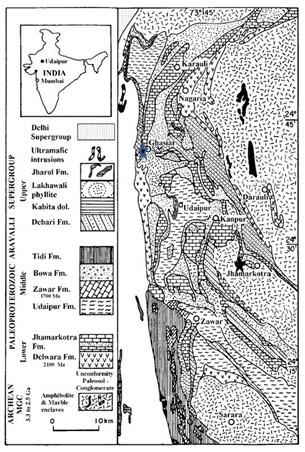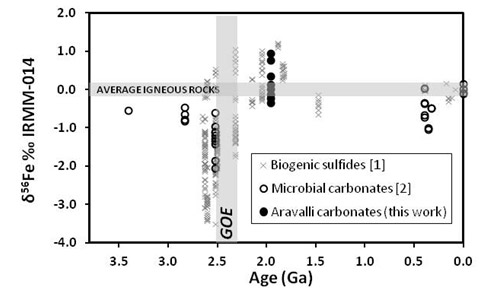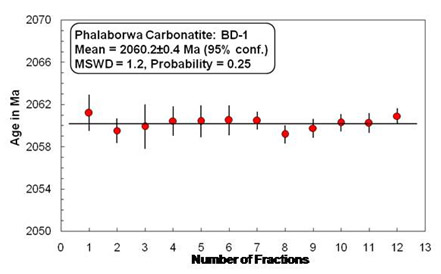Basic Science
| Title | MLP 6513-28(AK) |
|---|---|
| Participants | B. Sreenivas and Anil Kumar |
| Sponsoring Agency | CSIR-NGRI |
Work Description:
Fe isotope compositons of 13C enriched carbonates from the Paleoproterozoic Aravalli Supergroup, NW India
The Fe isotope compositions of biogenic sulfides document evidence for the ‘Great Oxidation Event’ (GOE) at ~ 2.32 Ga, defined by variable and negative δ56Fe values prior to 2.3 Ga and positive values during post-GOE period [Rouxel et al., 2005, Science 307, 1088-1091, (1)]. Subsequently, it has been shown that the Late Archean microbial carbonates also are characterized by negative and variable δ56Fe values between -2.06 and -0.47 ‰ IRMM-014, while the Phanerozoic and modern ones exhibit a narrow δ56Fe range of -1 to 0 ‰ [von Blanckenburg et al., 2008, Chem. Geol249, 113-128 (2)]. Here, we report Fe isotope compositions of ~ 2.0 Ga carbonate rocks and stromatolitic phosphorites from the Paleoproterozoic Aravalli Supergroup of North western India (Fig. 12.1) to decipher the effects of GOE in the Fe isotope record of microbial carbonates. The Aravalli carbonates of the Jhamarkotra Formation are characterized positive δ13C values up to 12 ‰ V-PDB while the phosphatic stromatolites show enrichment of 13C in organic carbon constituting the unique example from Indian rock record for global 13C excursions during the Paleoproterozoic. These samples show rare earth element and Yttrium patterns similar to seawater sources indicating that their Fe isotope compositions represent that of hydrogenous carbonates and hence reflecting the seawater Fe rather than those of primary or secondary Fe-Mn oxides. The samples show δ56Fe values from -0.34 to 0.93 ‰, similar to the Paleoproterozoic biogenic sulfides (Fig.12.2). Overall, the global Fe isotope data on microbial carbonates including the Aravalli examples define a secular trend similar to that of biogenic sulfides thereby indicating control of GOE on the marine Fe isotope geochemical cycle.
(B. Sreenivas, B. Vijaya Gopal, Y.J. Bhaskar Rao)
Precise 207Pb–206Pb baddeleyite geochronology by the thermal extraction thermal ionization mass spectrometry method.
The ability to easily obtain precise (~0.1%) age determinations on mafic rocks can open new avenues of research investigations related to mantle processes and paleocontinental redistribution. We present high precision Pb age determinations on baddeleyite (ZrO2), a common accessory mineral in mafic rocks using thermal extractionthermal ionization mass spectrometer (TE-TIMS) method. To constrain thermal extraction of Pb from baddeleyite, SEM back-scattered electron images along with energy-dispersive x-ray spectroscopy spot analysis were acquired at progressively increasing temperature between 1200 and 1590°C. Replicate analyses of twelve preheated (at 1250°C) silica embedded baddeleyite fractions from the Phalaborwa carbonatite standard using this procedure has yielded a 207Pb–206Pb weighted mean age of 2060.2±0.4 Ma (Fig 12.3), consistent with previously reported 207Pb–206Pb ages for this carbonatite standard at 2059.7 ± 0.35Ma determined by the conventional U-Pb isotope dilution-thermalionization mass spectrometry (ID-TIMS) technique. Our results demonstrate that thermal extraction 207Pb–206Pb ages are comparable with conventional U-Pb ages in both accuracy and precision. This procedure does not need ultraclean laboratory conditions (<1 pg procedure blanks), a prerequisite for conventional high precision U-Pb geochronology, and hence can be easily practiced in most TIMS isotope geochemistry laboratories.
(Anil Kumar, D. S. Sarma, E. Nagaraju, V. Parasharamulu)

Fig.12.1:
Geological map of part of the Aravalli Supergroup.The 13C enriched carbonates from Ghasiar and Jhamarkotra are marked with a star.

Fig.12.2:
Fe isotope compositions of biogenic sulphides [after 1], microbial carbonates [after2] and new data on Aravalli carbonates.The horizontal grey shaded region represents the Fe isotope compositions of igneous rocks and the vertical one denotes the timing of GOE

Fig.12.3:
TE-TIMS weighted mean 207Pb/206Pb ages on 12 baddeleyite fractions from the Phalaborwa carbonatite. Errors bars represent 95% confidence limits of measurements.